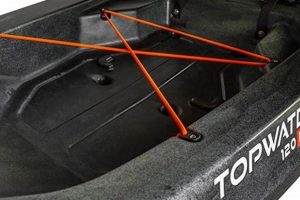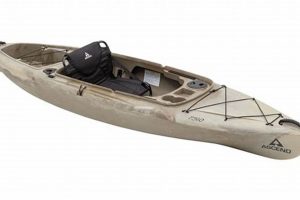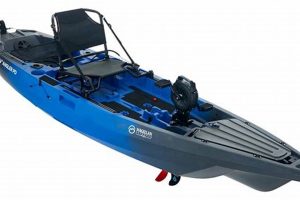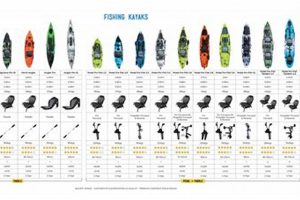Optimizing a kayak for fishing involves a strategic approach to equipment placement and selection. This process includes considerations such as rod holder positioning, tackle organization, electronics installation, and safety gear integration. A well-planned setup enhances angler efficiency, comfort, and overall fishing success. For example, mounting rod holders within easy reach allows for quick reactions to strikes, while a strategically placed fish finder provides crucial underwater insights.
Effective organization and customization are key to a productive and enjoyable experience on the water. A thoughtfully arranged kayak provides anglers with a significant advantage, minimizing wasted time and maximizing fishing opportunities. Historically, kayak fishing relied on simpler setups, but advancements in technology and equipment have led to more specialized and sophisticated configurations. This evolution underscores the growing recognition of the importance of a tailored approach to kayak outfitting.
The following sections will delve into specific areas of customization, covering essential topics such as choosing appropriate rod holders, organizing tackle for quick access, selecting and mounting electronics, ensuring safety and stability, and adapting setups for different fishing styles and target species.
Kayak Fishing Setup Tips
Optimizing a kayak for fishing involves careful consideration of several factors. These tips offer guidance on creating a setup that enhances both efficiency and enjoyment on the water.
Tip 1: Prioritize Stability: Kayak stability is paramount, especially when fishing. Consider kayak width, hull design (e.g., flat bottom, pontoon), and weight capacity. Added stability ensures angler safety and facilitates casting and retrieving.
Tip 2: Strategic Rod Holder Placement: Position rod holders within easy reach, angled for quick access and retrieval. Consider different types of rod holders (flush mount, adjustable) based on fishing style and target species.
Tip 3: Efficient Tackle Organization: Utilize tackle boxes, trays, and bags designed for kayak fishing. Prioritize waterproof storage and arrange tackle by lure type or fishing technique for quick access.
Tip 4: Electronics Integration: Fish finders and GPS units provide valuable information. Mount electronics securely within clear view and easy reach, ensuring transducer placement is optimized for accurate readings.
Tip 5: Safety First: Always wear a personal flotation device (PFD). Carry essential safety gear, including a whistle, signaling device, and first-aid kit. Inform someone of your fishing plans, including location and expected return time.
Tip 6: Anchor System Considerations: Choose an anchor appropriate for the fishing environment (e.g., sand, rock). Consider anchor trolley systems for controlled drift fishing and easier retrieval.
Tip 7: Paddle and Leash Selection: Select a paddle appropriate for kayak size and fishing style. Use a paddle leash to prevent loss in case of a capsize.
By implementing these tips, anglers can create a personalized kayak fishing setup that maximizes efficiency, comfort, and safety, ultimately contributing to a more rewarding fishing experience.
Further exploration of specific equipment choices and rigging techniques will be covered in subsequent sections.
1. Stability
Stability forms the foundation of a successful kayak fishing setup. A stable platform is crucial not only for safety but also for effective casting, retrieving, and landing fish. Compromised stability negatively impacts angler performance and can create hazardous situations. Understanding the factors that contribute to stability is essential for optimizing a kayak fishing setup.
- Kayak Selection:
Kayak design significantly influences stability. Wider kayaks with flatter hulls generally offer greater initial stability, making them suitable for calmer waters and stand-up fishing. Narrower kayaks with rounded or V-shaped hulls prioritize speed and maneuverability but sacrifice some stability. Choosing a kayak appropriate for the intended fishing environment and angler experience is paramount. For example, a wider, sit-on-top kayak provides a more stable platform for beginners or those fishing in sheltered bays, while a longer, narrower kayak might be preferred for experienced anglers tackling open water or strong currents.
- Weight Distribution:
Proper weight distribution plays a vital role in maintaining kayak stability. Distributing weight evenly and low in the kayak minimizes the risk of tipping. Securing heavier items, such as tackle boxes and batteries, close to the center of gravity enhances stability. Consider the impact of gear placement on balance, particularly when moving around the kayak. For instance, placing a heavy cooler directly behind the seat can create instability, while distributing weight evenly throughout the storage compartments promotes balance.
- Environmental Factors:
Wind, waves, and currents significantly impact kayak stability. Understanding how these forces affect the kayak and adjusting fishing techniques accordingly is crucial for maintaining balance. Strong winds can easily push a kayak off course, while waves and currents can create instability, especially when approaching from the side. Anglers should be prepared to adjust their position or seek sheltered areas when faced with challenging conditions. For example, anchoring in a protected cove can provide respite from strong winds, while adjusting paddling technique can compensate for currents.
- Angler Behavior:
Angler movements within the kayak directly influence stability. Sudden shifts in weight, leaning too far over the side, or standing up abruptly can compromise stability and lead to capsizing. Practicing smooth, controlled movements and maintaining a low center of gravity contributes significantly to overall stability. For example, leaning into a turn enhances stability while making quick, jerky movements increases the risk of tipping.
Considering these facets of stability during the kayak fishing setup process ensures a safe and productive experience. By carefully selecting a kayak appropriate for the intended environment and angler experience, distributing weight evenly, understanding environmental factors, and practicing controlled movements, anglers can maximize their stability and focus on the task at hand catching fish.
2. Rod Holder Placement
Rod holder placement is a critical element within the broader context of kayak fishing setup tips. Effective placement directly influences angler efficiency, safety, and overall fishing success. Incorrect placement can lead to tangled lines, lost fish, and potentially hazardous situations. Strategic placement, conversely, facilitates seamless transitions between paddling, casting, and fighting fish. Consider the cause-and-effect relationship: a poorly placed rod holder might snag fishing line during casting, resulting in a missed strike. Conversely, a well-placed holder allows for a smooth, unobstructed cast, increasing the likelihood of a successful hookup. For example, positioning rod holders near the bow within easy reach enables quick reactions to bites while trolling.
Optimal rod holder placement varies based on fishing style and target species. Anglers targeting larger, stronger fish might prefer rod holders positioned closer to the center of the kayak for increased leverage and control during a fight. Those fishing in tight quarters, such as mangrove tunnels or rocky shorelines, benefit from rod holders angled to minimize line snags and facilitate vertical jigging. Practical applications include adjustable rod holders that allow anglers to modify the angle and position based on changing conditions or fishing techniques. Another example is the use of multiple rod holders, allowing anglers to employ different fishing methods simultaneously. Mounting rod holders within easy reach eliminates the need to awkwardly reposition during a critical moment, maximizing fishing time and minimizing frustration.
Careful consideration of rod holder placement significantly enhances the overall kayak fishing experience. Addressing this aspect during the setup phase contributes to a more organized, efficient, and ultimately, more successful outing. Challenges can arise when attempting to balance rod holder accessibility with other onboard equipment, necessitating careful planning and potential compromises. Integrating rod holder placement within a comprehensive approach to kayak outfitting optimizes the angler’s interaction with the environment and enhances the probability of a successful catch. This reinforces the significance of rod holder placement as a fundamental component of effective kayak fishing setup.
3. Tackle Organization
Effective tackle organization is integral to efficient kayak fishing setups. A well-organized system directly impacts an angler’s ability to quickly locate and deploy necessary equipment, maximizing fishing time and minimizing disruptions. Disorganized tackle, conversely, leads to frustration, wasted time, and potentially missed opportunities. This section explores the facets of tackle organization within the context of kayak fishing.
- Storage Solutions:
Appropriate storage solutions form the foundation of organized tackle. Utilizing waterproof containers, tackle boxes with adjustable compartments, and specialized kayak fishing bags protects equipment from the elements and facilitates efficient retrieval. Examples include waterproof cases for electronics and soft-sided tackle bags designed to conform to kayak spaces. These solutions safeguard against water damage and keep gear organized, contributing significantly to a smooth and productive fishing experience. Selecting storage solutions that fit within the kayak’s limited space maximizes available area.
- Categorization and Accessibility:
Categorizing tackle by lure type, size, or fishing technique streamlines the selection process. Storing frequently used items within easy reach minimizes time spent searching through boxes. For example, designating separate compartments for topwater lures, crankbaits, and soft plastics allows for rapid retrieval. Placement considerations within the kayak also contribute to efficiency. Storing lures used for the targeted species in readily accessible locations further streamlines the process. This logical organization allows anglers to adapt quickly to changing fishing conditions or target different species without disrupting the flow of the fishing experience.
- Line Management:
Proper line management is crucial for preventing tangles and ensuring smooth casting. Employing line spools, leader organizers, and tools like line cutters and pliers keeps lines organized and readily accessible. These practices contribute to a more efficient fishing experience, preventing frustrating interruptions caused by tangled lines. For example, using a line winder to spool new line onto reels or employing a leader wallet to store pre-tied leaders minimizes downtime on the water. Efficient line management, integrated within a broader organizational strategy, contributes significantly to a seamless and enjoyable fishing trip.
- Minimizing Footprint:
Minimizing the physical footprint of tackle within the kayak is crucial for maintaining stability and maneuverability. Selecting compact storage solutions, eliminating unnecessary items, and securing loose gear prevents clutter and improves overall safety. For example, opting for smaller tackle boxes or utilizing stackable containers reduces the overall space occupied by tackle. Minimizing the footprint contributes to a more balanced and stable kayak, allowing for greater freedom of movement and enhancing the overall fishing experience.
By implementing these organizational strategies, anglers transform their kayaks into efficient fishing platforms. The interplay between these elements contributes directly to a more streamlined and enjoyable fishing experience. An organized kayak reduces stress, maximizes fishing time, and ultimately increases the likelihood of a successful outing. This reinforces the significance of tackle organization as a fundamental component of effective kayak fishing setup.
4. Electronics Integration
Integrating electronics significantly enhances contemporary kayak fishing setups. Strategic electronics selection and placement provide anglers with critical real-time data, improving fishing efficiency and overall success. This integration requires careful consideration of power management, mounting solutions, and device compatibility. Understanding the interplay between electronics and the kayak environment is crucial for maximizing their benefits.
- Fish Finders:
Fish finders utilize sonar technology to provide underwater views, revealing bottom structure, fish location, and depth. Models range from basic units displaying depth and fish arches to advanced systems with GPS, chartplotting, and side-scanning capabilities. Choosing a fish finder appropriate for the target species and fishing environment is essential. A kayak angler targeting offshore reefs might require a more powerful fish finder with greater depth penetration than an angler fishing in shallow freshwater lakes. Proper transducer placement is critical for accurate readings and optimal performance. Mounting the transducer on the kayak’s hull or utilizing a trolling motor transducer provides different perspectives and data insights.
- GPS and Navigation:
GPS units and chartplotters aid navigation, allowing anglers to mark waypoints, track routes, and navigate safely, especially in unfamiliar waters or challenging conditions. Integration with fish finders often provides a comprehensive view of both underwater structures and surface navigation data. This combined information allows anglers to precisely target specific locations, return to productive fishing spots, and navigate safely in low-visibility conditions like fog. Features such as trackback and waypoint marking are invaluable for ensuring safe return journeys, especially in vast bodies of water or areas with complex shorelines. Waterproof and ruggedized GPS units designed for marine environments are essential for reliable performance in kayak fishing conditions.
- Trolling Motors:
Electric trolling motors provide hands-free propulsion and precise boat control, particularly useful for techniques like slow trolling or maintaining position in currents. Integrating a trolling motor into a kayak fishing setup requires consideration of battery capacity, motor size, and mounting options. A smaller, transom-mount trolling motor might suffice for maneuvering in calm lakes, while a larger, bow-mount motor might be necessary for navigating rivers or strong currents. Power management is crucial, ensuring sufficient battery power for both the motor and other electronics. Proper wiring and fuse protection safeguards the electrical system and prevents damage from overloads.
- Power Management:
Powering multiple electronic devices necessitates careful power management strategies. Utilizing marine-grade batteries with sufficient capacity, incorporating charging systems, and employing power-saving features on devices ensures uninterrupted operation throughout the fishing trip. Calculating the power consumption of each device and selecting a battery with ample capacity is crucial. Options include dedicated marine batteries or portable power packs. Regularly charging batteries and monitoring their health ensures reliable performance and extends their lifespan. Properly connecting and securing wiring minimizes the risk of electrical faults and ensures safe operation.
Effective integration of electronics transforms a kayak into a sophisticated fishing platform. The strategic interplay of these components contributes to increased efficiency, enhanced safety, and ultimately, a more rewarding angling experience. Connecting these individual elements within the framework of a comprehensive kayak fishing setup underscores the importance of a systematic approach to equipment selection, placement, and power management. This holistic approach maximizes the benefits of technology, allowing anglers to focus on the core pursuitfishing.
5. Safety Equipment
Safety equipment is paramount in kayak fishing setups. Prioritizing safety ensures angler well-being and facilitates a focused fishing experience, free from unnecessary risks. A comprehensive safety approach integrates essential equipment and practices into the overall setup, enhancing preparedness for unforeseen circumstances.
- Personal Flotation Device (PFD):
A properly fitted PFD is non-negotiable. It provides essential buoyancy in the event of a capsize, increasing survival chances in cold water or challenging conditions. Different PFD types exist, including inflatable and inherently buoyant vests. Selecting a comfortable, appropriately sized PFD encourages consistent wear. Integrating PFD selection into the initial kayak fishing setup process ensures anglers prioritize this fundamental safety measure from the outset. For example, an angler fishing in rough waters might choose an inherently buoyant PFD with additional features like a whistle and reflective tape.
- Signaling Devices:
Carrying signaling devices, such as a whistle, air horn, or flares, enables communication in emergencies. These tools attract attention and facilitate rescue efforts if an angler becomes stranded or injured. A waterproof pouch or container protects signaling devices from the elements and ensures functionality when needed. Integrating signaling devices into the kayak’s storage system ensures easy access in critical situations. For instance, attaching a whistle to the PFD allows for immediate use in the event of a capsize.
- First-Aid Kit:
A well-stocked first-aid kit addresses minor injuries and provides essential supplies until professional medical assistance can be obtained. Contents might include bandages, antiseptic wipes, pain relievers, and sunscreen. A waterproof container protects the kit’s contents from water damage. Regularly checking and replenishing supplies ensures the kit remains adequately stocked. For example, including specialized items like a fishhook remover or motion sickness medication caters to specific fishing-related risks.
- Communication Devices:
Carrying a waterproof cell phone or VHF radio enables communication with emergency services or shore contacts. Informing someone of fishing plans, including location and expected return time, provides an additional safety layer. A fully charged battery and knowledge of emergency contact procedures are crucial. Protecting electronic devices in waterproof cases ensures functionality in wet conditions. For example, a VHF radio provides reliable communication in areas with limited cell phone coverage, while a personal locator beacon (PLB) can summon emergency assistance in life-threatening situations.
Integrating these safety measures within a broader kayak fishing setup demonstrates a commitment to responsible angling practices. Safety equipment is not merely an add-on but a fundamental aspect of a well-planned and executed fishing trip. This proactive approach minimizes potential risks, allowing anglers to focus on the enjoyment and challenge of fishing while ensuring their well-being on the water. By prioritizing safety from the initial setup phase, anglers create a foundation for a more secure and ultimately more rewarding fishing experience.
Frequently Asked Questions
Addressing common queries regarding kayak fishing setups provides clarity and facilitates informed decision-making. These FAQs offer practical insights into optimizing kayak configuration for enhanced fishing experiences.
Question 1: How does kayak stability influence fishing success?
Kayak stability directly impacts casting accuracy, line management, and the ability to fight fish effectively. A stable platform enhances angler comfort and safety, contributing to a more focused and productive fishing experience. Reduced stability can hinder casting precision and compromise safety, particularly when handling larger fish or navigating challenging waters.
Question 2: What factors should be considered when choosing rod holders?
Rod holder selection depends on fishing style, target species, and kayak compatibility. Factors include mounting options (flush mount, track mount), adjustability, and material. Matching rod holders to specific fishing techniques, such as trolling or jigging, maximizes efficiency and rod security. Material durability ensures long-term performance in harsh marine environments.
Question 3: How can tackle be organized efficiently in a kayak?
Efficient tackle organization maximizes fishing time by enabling quick access to necessary equipment. Utilizing waterproof storage solutions, categorizing lures by type or technique, and minimizing unnecessary items contribute to a streamlined and organized kayak. This reduces clutter and facilitates rapid lure changes, optimizing fishing efficiency.
Question 4: What electronic devices enhance kayak fishing?
Electronics such as fish finders, GPS units, and trolling motors provide valuable data and enhance fishing capabilities. Fish finders reveal underwater structures and fish locations. GPS aids navigation and waypoint marking. Trolling motors provide hands-free propulsion and precise boat control. Integrating these tools strategically enhances fishing success and safety.
Question 5: What essential safety equipment should be included in a kayak fishing setup?
Essential safety equipment includes a properly fitted personal flotation device (PFD), signaling devices (whistle, air horn), a first-aid kit, and communication devices (waterproof cell phone or VHF radio). These items ensure angler safety and preparedness for unforeseen circumstances, promoting responsible angling practices.
Question 6: How can one adapt a kayak fishing setup for different target species?
Adapting a kayak setup involves adjusting rod and reel choices, lure selection, and potentially modifying rod holder placement or adding specialized equipment. Targeting larger species might necessitate heavier tackle and stronger rods, while finesse fishing requires lighter equipment. Adaptability maximizes success across diverse fishing scenarios.
Prioritizing safety, optimizing tackle organization, and selecting appropriate electronics contribute significantly to a productive and enjoyable kayak fishing experience. Addressing these key areas through informed decision-making and thoughtful setup enhances angler performance and overall satisfaction on the water.
Further information on specific equipment recommendations and advanced setup techniques can be found in the following sections.
Kayak Fishing Setup Tips
Effective kayak fishing setup hinges on a strategic approach to equipment selection, placement, and integration. Prioritizing stability ensures angler safety and efficient operation. Strategic rod holder placement facilitates seamless transitions between paddling, casting, and retrieving. Organized tackle systems maximize fishing time by enabling quick access to essential gear. Integrating electronics, such as fish finders and GPS, provides valuable real-time data enhancing fishing effectiveness. Prioritizing safety equipment, including PFDs and signaling devices, ensures angler well-being in unforeseen circumstances.
A well-planned kayak fishing setup transforms the vessel into a highly efficient and enjoyable fishing platform. Careful consideration of these key elements unlocks the full potential of kayak fishing, allowing anglers to fully immerse themselves in the pursuit. Adaptability and continuous refinement of setups, based on evolving experience and specific fishing targets, further enhance performance and enjoyment on the water.






